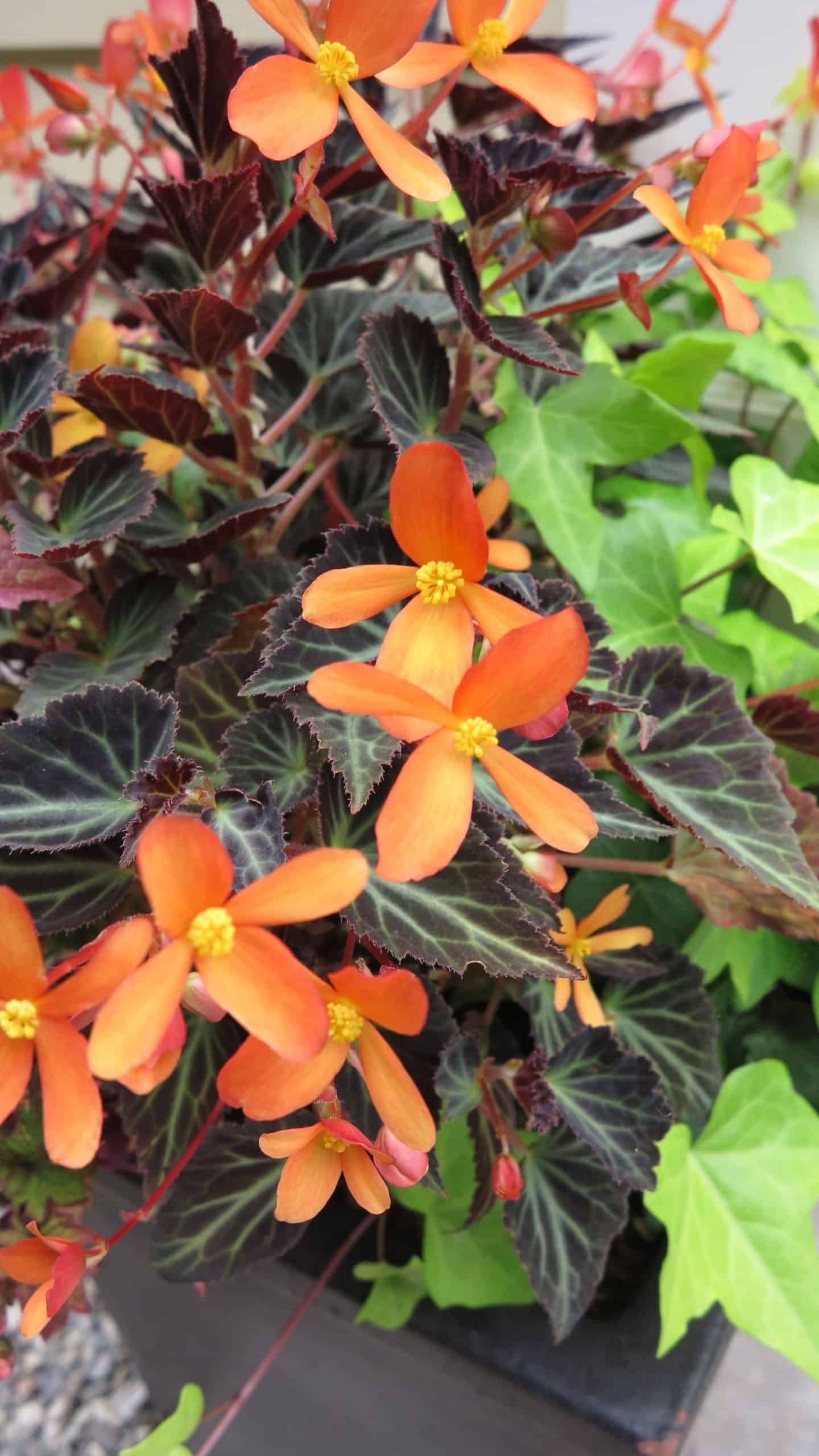
Last May one of my impulse buys was Sparks Will Fly begonia (Begonia boliviensis ‘Brothglow’, 18 x 18 inches / 45 x 45 cm). Its bright tangerine-orange flowers look dazzling against bronze leaves with light green veins. Displayed in a shady corner on my deck, this plant carried on blooming until early August. After a 10-day rest, it’s now full of flower buds and looks like it plans another brilliant show. I intend to bring it indoors for the winter, with the hope it will brighten a north-facing bay window. There are three plants clustered in the very full pot, and these could be separated and grown on for a bigger display next summer.
Now is the time to decide on what plants to bring inside for the winter. Day temperatures remain warm, but the nights are growing cooler; plants will begin to react to the change and eventually deteriorate. The best time to move a plant indoors is late summer, while they’re still tender and flush. Whenever I’ve waited until late September to move a pot or two inside, the change from outside to inside temperatures caused plants to drop their leaves. Considerable time was lost to rehabilitating them, and some never returned to healthy form. The shock of temperature change was too much for them.
I don’t bring many plants indoors, and those I do are already growing in containers. Lifting plants from garden soil invites problems with fungal infections and insect larvae. I use soilless mix in containers, so many soil fungi can be avoided, but potted plants can still carry insects. After the unusually wet summer, I won’t be surprised to find a few earwigs crawling out from my begonia. I just hope it’s a small number and not an entire nest.
Aside from being vigilant about critters on plants brought inside, I’ll do some pinching and cutting back of leggy stems. The transition period to inside growing conditions lasts about a month as the plants acclimatize to new temperature and light. Hopefully, they’ll stabilize without losing foliage. I’ll give them a feeding of liquid transplant solution, which contains a rooting hormone as well as nutrients; the same solution used when setting new plants into the garden outdoors. Thereafter, I won’t provide fertilizer again until late February, when plants sense spring’s arrival and want to get growing.
Sparks Will Fly is categorized as an annual, but it has a USDA hardiness Zone 9 rating, and is listed as cold tolerant down to 1°C. That makes me think it has a chance of being more permanent (with the right care and conditions) than an annual plant expected to complete its life cycle by the end of autumn. Gardening is all about risk, and I’m an incurable gambler. Sparks Will Fly will be coming inside for another lease on life.

Does anyone have clippings or access to Sparks Will Fly? I’ve been trying to locate this begonia for several years, and really love it!
Judith did the Sparks Will Fly survive inside? Not sure when you posted the info about taking it inside. I live in MN USA and want to try growing them inside over the winter. I grew water rootings last winter. So fingers crossed on bringing actual plants inside.
Deb
September 2020
It’s Nov 8, it’s 24 degrees F, and my beautiful begonia is dying on my front porch. It has been in full bloom from May-Nov. I hung it on the North Face of my garage, which gets very limited morning and late afternoon sun. I thought about winterring it over in the house, but decided not to. I will have more of these gorgeous plants in the future.
Hi Janice,
Sparks Will Fly (Begonia boliviensis) is native to Argentina and Bolivia, and grows from a tuberous root. Alstroemeria is grown from a cluster of tuberous roots, and is native to Chile (summer-blooming species) and Brazil (winter-blooming species). Alstroemeria is classified as a perennial plant, cold-hardy to 23°F / -5°C. Most of the garden alstroemeria sold in North America are the summer-blooming species. This plant will possibly keep its foliage if kept indoors over winter, but will stick to its blooming pattern, probably flowering in late spring and early summer. However, it takes strong light to induce good bloom, at least six hours of direct sun each day. Your Alberta winter is definitely too cold for the plant to survive in the ground, but you can take it in and put it into a pot, cut back the foliage, and store the roots in a cold dark place over winter. Bring the pot out into a sunny location in spring, and begin watering. Once foliage appears and is six to eight inches (15 to 20 cm) tall, feed with a water-soluble fertilizer (such as 10-15-10), and again in three weeks. I hope that works for you!
– Judith
Is that begonia a tuber? What do you think about overwintering a potted alstroemeria indoors? Put it to sleep or put in a cold north window and water barely? I live in Wetaskiwin, Alberta.
Thanks